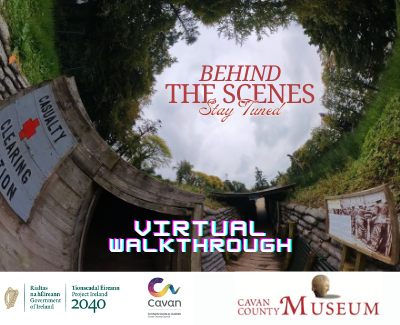


As part of the Cavan Connects initiative, we are excited to share an inside look at how we captured and processed the 360-degree virtual tour of the Cavan County Museum. This digital experience brings the museum’s extensive collection to life in a fully immersive, interactive format that allows people to explore Cavan’s history from anywhere in the world. But what does it take to create such an experience? Let’s take you behind the scenes.
Capturing a high-quality 360-degree virtual tour starts with detailed planning and collaboration between the Cavan Connects Network, the museum team, and digital specialists. Understanding the museum's layout, identifying key exhibits, and mapping out the visitor journey were essential first steps. Our goal was to highlight the museum’s most significant features while ensuring a seamless, enjoyable digital experience.
We worked closely with the museum curators to prioritize exhibits like the Battle of the Somme Trench Experience, the 1916 Easter Rising and War of Independence exhibit, and the GAA Exhibition, which tell important stories about Cavan’s past. This collaboration ensured that the virtual tour reflected the museum’s essence while using digital tools to expand its accessibility.
The core of the virtual tour experience relies on 360-degree photography. Using specialized cameras equipped with multiple lenses, our digital team captured panoramic images that cover every angle of the museum’s rooms and galleries. Each camera shoot is carefully staged to ensure nothing is missed, and lighting is optimized to showcase exhibits in their best light.
The process involved setting up the camera at multiple points throughout each gallery, capturing all the nooks and crannies that might otherwise be overlooked in a traditional photograph. For outdoor exhibits like the Somme Trench, extra care was taken to account for natural lighting conditions, ensuring a seamless transition between indoor and outdoor environments.
Once the 360-degree images were captured, the next step was image stitching. This is where advanced software is used to blend the multiple images into one continuous, navigable panorama. Each photo had to align perfectly with the next, creating a seamless 3D environment that gives users the feeling of walking through the museum in person.
During the stitching process, we also corrected any distortions and adjusted the colors to ensure consistency across the tour. By fine-tuning the visuals, we were able to create a smooth, immersive experience that mirrors reality. This part of the process requires careful attention to detail and often involves multiple revisions to ensure the highest quality.
A virtual tour is more than just static images. To bring the exhibits to life, we integrated interactive elements like clickable hotspots. These hotspots provide detailed information about artifacts, allowing users to engage with each item at their own pace. For instance, when exploring the Prehistoric Ireland Gallery, users can click on ancient pottery or tools to learn more about their history and significance.
This layer of interactivity transforms the tour from a passive viewing experience into an educational journey, providing context and storytelling that might otherwise require a museum guide. It also ensures that users can explore the museum in a self-directed way, discovering areas of interest based on personal curiosity.
Ensuring that the virtual tour was accessible on various devices—laptops, tablets, and smartphones—was a key priority for the Cavan Connects digital team. The tour was optimized for both desktop and mobile platforms, so no matter where users are, they can seamlessly explore the museum without lag or loss of quality.
This cross-device compatibility is vital in keeping with Cavan Connects’s commitment to digital inclusivity. We want everyone, regardless of the technology they have access to, to be able to enjoy the experience without any technical barriers.
Before launching the tour to the public, we conducted extensive testing. We invited museum staff, local educators, and members of the Cavan Connects Digital Champions team to explore the virtual tour and provide feedback. Their insights were crucial in refining the user experience, ensuring smooth navigation and resolving any technical glitches.
After several rounds of testing and updates, the tour was finally ready to launch! Thanks to the collaboration between the Cavan Connects team and our partners at the Cavan County Museum, we’ve created a digital experience that opens the doors of this historical treasure to anyone with an internet connection.
This virtual tour is just one example of how Cavan Connects is using technology to bridge the gap between the past and the present. By digitizing local heritage sites like the Cavan County Museum, we’re making our shared history more accessible to the entire community and beyond.
Moreover, this project aligns with our larger mission to enhance digital literacy across Cavan. With the help of our Digital Champions, those who might not feel comfortable navigating virtual spaces can receive the support they need to enjoy the tour and gain new digital skills in the process.